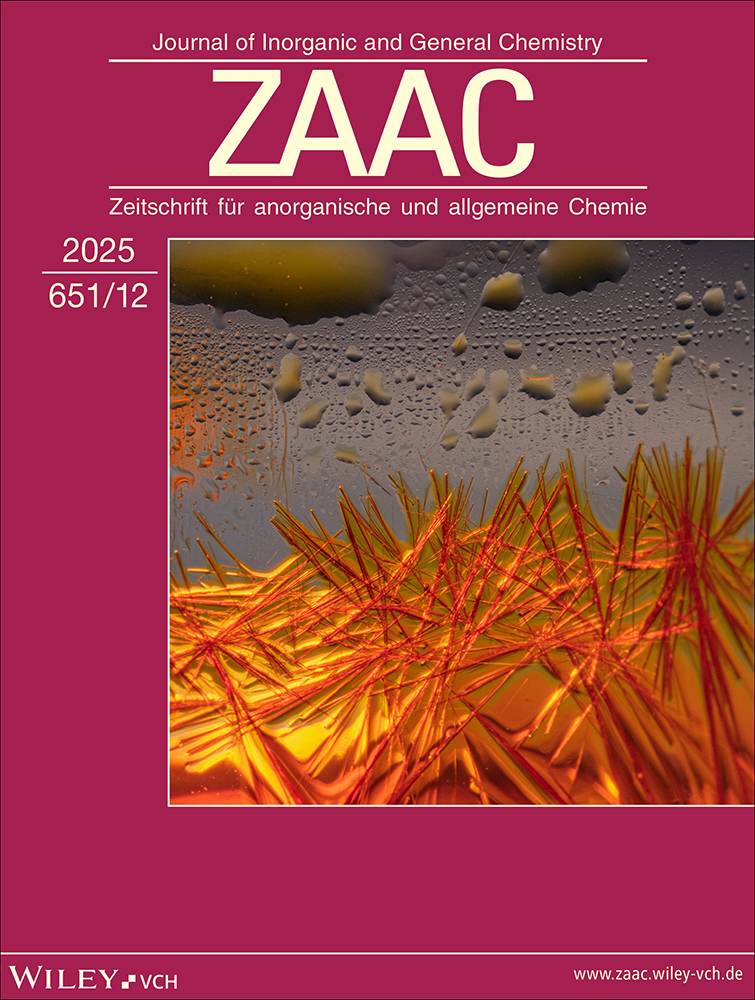Neue ternäre Phosphide und Arsenide mit einem Metall : Nichtmetall-Verhältnis im Bereich von 2 : 1
Abstract
deDurch Erhitzen entsprechend zusammengesetzter Elementgemenge bzw. deren Umsetzung in Sn- oder Pb-Schmelzen als Reaktionsmedium wurden sechs neue Verbindungen dargestellt, die röntgenographisch mit Einkristall-Methoden untersucht wurden. Sc2Ni12P7 (a = 9,013(1), c = 3,590(1) Å) kristallisiert im Zr2Fe12P7-Typ (P6; Z = 1); diesen bilden im wesentlichen auch die Verbindungen Eu2Pd12As7 (a = 10,040(1), c = 4,100(1) Å) und Sr2Rh12P7 (a = 9,626(1), c = 3,844(1) Å), bei denen aber eins von sieben Nichtmetallatomen eine etwas andere Umgebung besitzt und längs [001] fehlgeordnet ist. Ihre Kristallstrukturen entsprechen dem Ho2Rh12As7-Typ (P63/m; Z = 1). Ca2Ni7P4 (a = 3,703(1), b = 9,209(1), c = 10,378(1) Å) kristallisiert im Nd2Ni7P4-Typ (Pmn21; Z = 2), während die Kristallstrukturen von Ca4Rh13As9 (a = 3,903(3), b = 11,221(1), c = 19,411(4) Å) und Sm4Rh13As9 (a = 3,913(3), b = 11,242(6), c = 19,440(6) Å) dem Ho4Ir13Ge9-Typ (Pmmn; Z = 2) entsprechen; allerdings müssen bei ihnen die Positionen einer Rh-Lage mit einer Splitlage beschrieben werden. Bei allen sechs Verbindungen bilden die Übergangsmetallatome, die drei, vier oder fünf P- bzw. As-Atome zu ihren nächsten Nachbarn zählen, mit diesen jeweils ein dreidimensionales kovalent gebundenes Gerüst, dessen Hohlräume von den elektropositiven Metallatomen besetzt werden. Die Umgebung der P- bzw. As-Atome besteht meist aus trigonalen Metallatomprismen, deren Rechteckflächen von weiteren Metallatomen überdacht sind und die charakteristisch ist für ternäre Phosphide und Arsenide mit einem Metall : Nichtmetall-Verhältnis im Bereich von 2 : 1.
Abstract
enNew Ternary Phosphides and Arsenides with a Metal : Non-Metal Ratio in the Range of 2 : 1
Six new compounds were prepared by heating mixtures of the elements or by reaction of them in a tin(lead) flux. They were investigated by single crystal X-ray methods. Sc2Ni12P7 (a = 9.013(1), c = 3.590(1) Å) crystallizes in the Zr2Fe12P7 type structure (P6; Z = 1), which is basically built up likewise by Eu2Pd12As7 (a = 10.040(1), c = 4.100(1) Å) and Sr2Rh12P7 (a = 9.626(1), c = 3.844(1) Å), but one of seven non-metal atoms has a somewhat modified environment and is disordered along [001]. Therefore their crystal structure corresponds to the Ho2Rh12As7 type structure (P63/m; Z = 1). Ca2Ni7P4 (a = 3.703(1), b = 9.209(1), c = 10.378(1) Å) forms the Nd2Ni7P4 type structure (Pmn21; Z = 2), whereas the atomic arrangements of Ca4Rh13As9 (a = 3.903(2), b = 11.221(1), c = 19.411(4) Å) and Sm4Rh13As9 (a = 3.913(2), b = 11.242(6), c = 19.440(6) Å) correspond basically to the Ho4Ir13Ge9 type structure (Pmmn; Z = 2), but the disorder of Rh8 required the occupation of splitting positions. The transition metals have three, four or five neighbouring atoms of phosphorus or arsenic and form together with them three-dimensional covalent frameworks, of which holes are occupied by the atoms of the electropositive metal. Most of the polyhedra around the P and As atoms respectively consist of trigonal prisms of metal atoms with additional metal atoms capping the rectangular faces of the prisms. This environment ist characteristic for ternary phosphides and arsenides with a metal : non-metal ratio in the range of 2 : 1.




